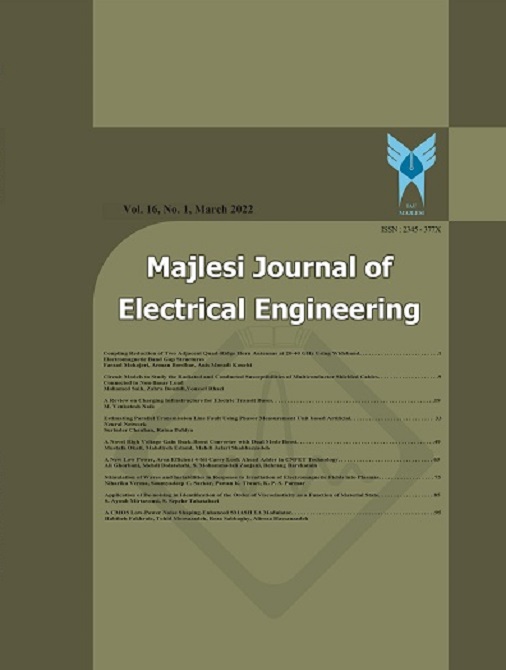[1] W. M. Arden, “The international technology roadmap for semiconductors—perspectives and challenges for the next 15 years,” Curr. Opin. Solid State Mater. Sci., vol. 6, no. 5, pp. 371–377, 2002.
[2] S. Angizi, S. Sarmadi, S. Sayedsalehi, and K. Navi, “Design and evaluation of new majority gate-based RAM cell in quantum-dot cellular automata,” Microelectronics J., vol. 46, no. 1, pp. 43–51, 2015.
[3] SS. Ahmadpour, M. Mosleh “A novel fault-tolerant multiplexer in quantum-dot cellular automata technology,” The Journal of Supercomputing 74 (9):4696-4716, 2018.
[4] S. Sarmadi, S. Sayedsalehi, M. Fartash, and S. Angizi, “A Structured Ultra-Dense QCA One-Bit Full-Adder Cell,” Am. Sci. Publ., vol. 4, no. 6, pp. 10–15, 2015.
[5] F. Ahmad, G. M. Bhat, H. Khademolhosseini, S. Azimi, S. Angizi, and K. Navi, “Towards single layer quantum-dot cellular automata adders based on explicit interaction of cells,” J. Comput. Sci., vol. 16, no. February, pp. 8–15, Sep. 2016.
[6] R. Farazkish, “A new quantum-dot cellular automata fault-tolerant full-adder,” J. Comput. Electron., vol. 14, no. 2, pp. 506–514, 2015.
[7] M. Abutaleb, “Robust and efficient QCA cell-based nanostructures of elementary reversible logic gates,” The Journal of Supercomputing 74 (11):6258-6274, 2018.
[8] M. Hayati and A. Rezaei, “Design of novel efficient adder and subtractor for quantum‐dot cellular automata,” Int. J. Circuit Theory Appl., vol. 43, no. 10, pp. 1446–1454, 2015.
[9] K. Navi, H. Mohammadi, and S. Angizi, “A Novel Quantum-Dot Cellular Automata Reconfigurable Majority Gate with 5 and 7 Inputs Support,” J. Comput. Theor. Nanosci., vol. 12, no. 3, pp. 399–406, Mar. 2015.
[10] S. Hashemi, MR. Azghadi,K. Navi, “Design and analysis of efficient QCA reversible adders,” The Journal of Supercomputing:1-20, 2018.
[11] S. Angizi, F. Danehdaran, S. Sarmadi, S. Sheikhfaal, N. Bagherzadeh, and K. Navi, “An Ultra-High Speed and Low Complexity Quantum-Dot Cellular Automata Full Adder,” J. Low Power Electron., vol. 11, no. 2, pp. 173–180, 2015.
[12] H. B. Sousan, M. Mosleh, and S. Setayeshi, “Designing and Implementing a Fast and Robust Full- Adder in Quantum-Dot Cellular Automata ( QCA ) Technology,” vol. 6, no. 1, pp. 27–45, 2015.
[13] SR. Heikalabad, MN. Asfestani, M . Hosseinzadeh “A full adder structure without cross-wiring in quantum-dot cellular automata with energy dissipation analysis,” The Journal of Supercomputing 74 (5):2018.
[14] A. Roohi, H. Khademolhosseini, S. Sayedsalehi, and K. Navi, “A symmetric quantum-dot cellular automata design for 5-input majority gate,” J. Comput. Electron., vol. 13, no. 3, pp. 701–708, 2014.
[15] K. Navi, A. Roohi, and S. Sayedsalehi, “Designing reconfigurable quantum-dot cellular automata logic circuits,” J. Comput. Theor. Nanosci., vol. 10, no. 5, pp. 1137–1146, 2013.
[16] S. Hashemi, M. Tehrani, and K. Navi, “An efficient quantum-dot cellular automata full-adder,” Sci. Res. Essays, vol. 7, no. 2, pp. 177–189, 2012.
[17] E. Taherkhani, MH. Moaiyeri, S. Angizi “Design of an ultra-efficient reversible full adder-subtractor in quantum-dot cellular automata,” Optik 142:557-563. 2017.

